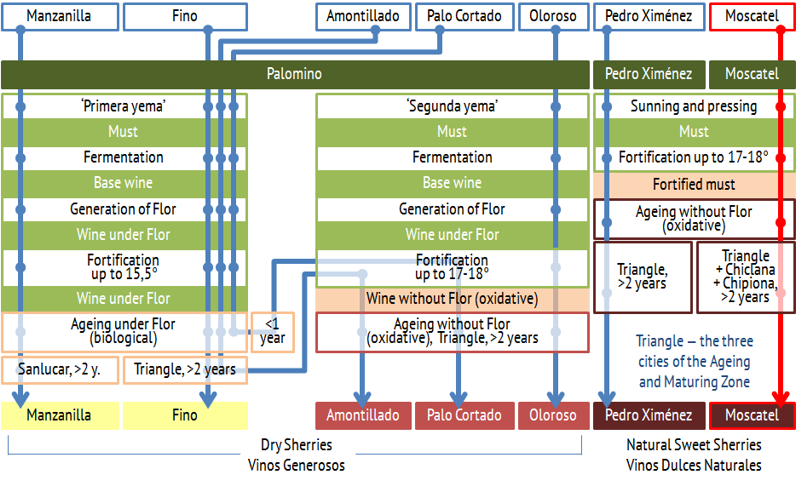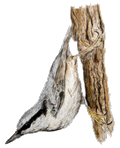
- Sherry Wine:
- Production
- Classification
- Cities & Bodegas
- Tastings
- Analogues
- Authors & Contacts
- Ðóññêèé ñàéò
Sherry wine types
Moscatel
Olga Nikandrova and Denis Shumakov.
Moscatel is a natural sweet sherry produced from very ripe or raisined grapes of Moscatel variety and oxidatively aged.

Its processing technology is almost identical to the one of Pedro Ximénez — small differences lie only in the withering technology, which is natural, since the grape variety is different. All the rest is the same. With difficulty raisined grapes are pressed to receive must (Moscatel berries are a bit bigger, they retain more water and give a little more must), then with difficulty the must is fermented, then alcohol is added, and finally all this is aged dynamically. Simple, but with some nuances.
First, Moscatel, unlike the other sherries, may be aged not only in the towns of the Ageing and Maturing Zone, but also in Chiclana de la Frontera and Chipiona.
Second, Chipiona and Chiclana de la Frontera produce a lot of noticeably different (even in their color) wine from Moscatel grape. There can be light and airy (but nevertheless sweet) Moscatels. And there can be rich and dark (the richest and darkest of the are usually called Moscatel de Pasa or Moscatel de Pasas, which mean “Moscatel made from raisined grapes”). The official sherry range includes the darker version of Moscatel produced from very ripe or sunned berries and aged oxidatively in the Soleras and Criaderas system.

Moscatel (it is dark)
in the place of its production
So. Moscatel is thick and sweet wine with sugar content higher than 160 grams per liter and alcoholic strength of 15-22°, usually a bit lighter than Pedro Ximénez (from chestnut to mahogany). Its aroma presents rather surprising tones of flowers (jasmine, honeysuckle, fleur de oranger) and citrus (lemon, grapefruit). The taste is moderately sweet, with nutmeg and floral tones. The aftertaste is accurate and somewhat dry.
In theory, Moscatel can also be used as a basis for sherry specialties, but haven’t heard of them so far. The origin of the name of this sherry is obvious.
Moscatel can be served and consumed in the same style as Pedro Ximénez. A traditional special sherry glass or an ITG would go, but a liqueur glass would do even better. Recommended serving temperature is 12-14°C, but Moscatel can be also served at our room temperature or, on the contrary, strongly cooled (the former version will have sharper baked-bread notes).
Neverless, we have to admit that, despite stylistic similarities in serving and consuming, Moscatel is evidently different from Pedro Ximénez in its taste, flavor, and gastronomic nuances. Official recommendations on pairing Moscatel with food include different dainties: starting with different pies, profiteroles, and tiramisu to fresh grapes. The fact that pastry dominates in these recommendations is only logical — pies and cupcakes would make a perfect gastronomic rhyme to the baked moscatel note. And lemon cake — with a citrus note, which is not uncommon for Moscatels.
Only this note already makes sense for hunting for and tasting this drink.
Moscatels reviewed on the website (in Russian only):
— Lustau Moscatel Emilín
— Moscatel de Pasas Los Madroñales
— Bodegas San Sebastián Moscatel de Pasa
— Bodegas San Sebastián Moscatel Blanco
— Bodegas F.J. Ruiz Moscatel El Viejo Dorado
— Moscatel Gloria Naranja
— Bodegas César Florido Moscatel de Pasas
— Colosia Moscatel Soleado
— Moscatel Dulce Alexandro
— Alvear Moscatel
— Barbadillo Laura Moscatel
— Esnobista Moscatel Pasa
Read next — Blended Sherries.
Warning!
This site can contain information about drinks excessive consumption of which may cause harm to health and is unadvisable for people who didn’t come of age.
Share Sherry
- Sherry.wine, FEDEJEREZ
- Copa Jerez, Sherry Week
- Sherry Notes, Jerez de Cine
- Los Generosos, Criadera
- Jerez-Xeres-Sherry
- Los Vinos de Jerez
Articles
- There are more articles in Russian than in English in this website. Sorry :(
Reviews
- To our great regret, we didn’t have time to translate tasting and traveling notes into English. But, if you want, you can see them in Russian.

